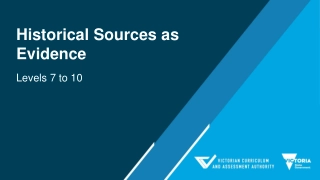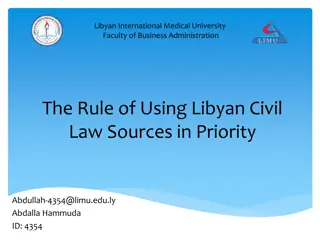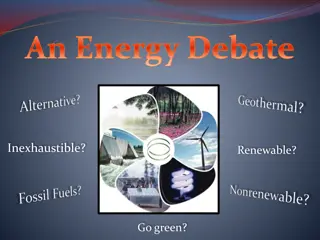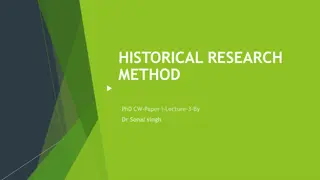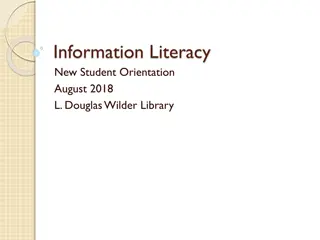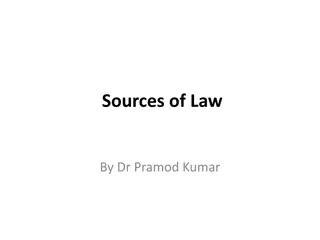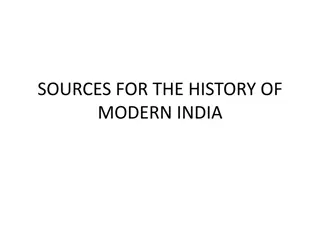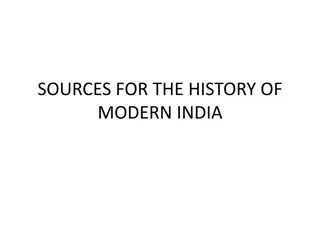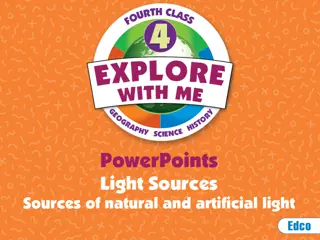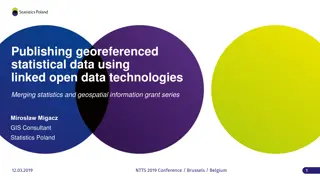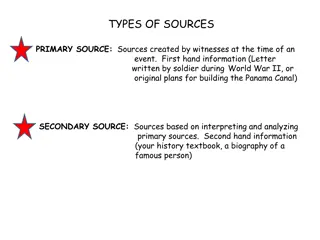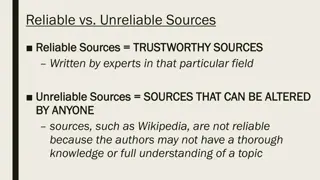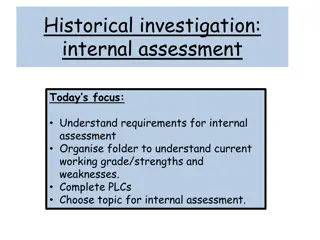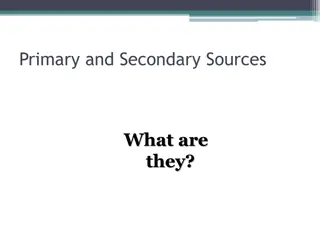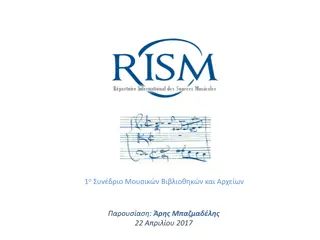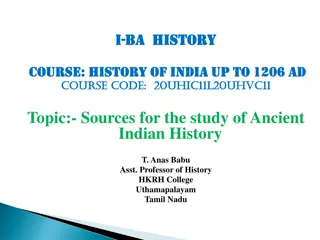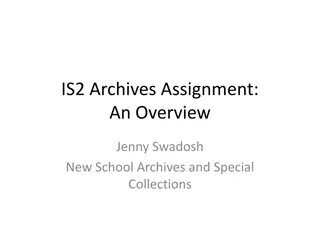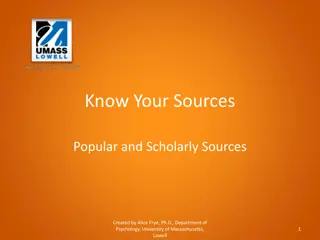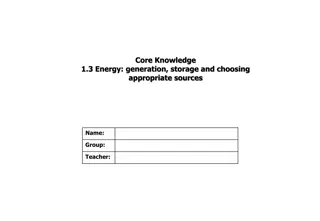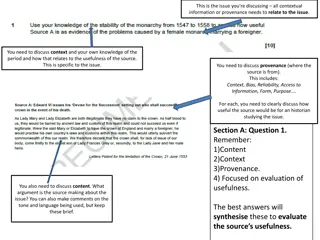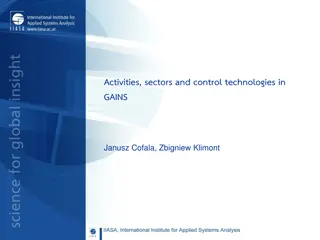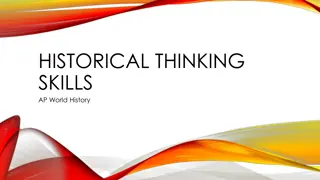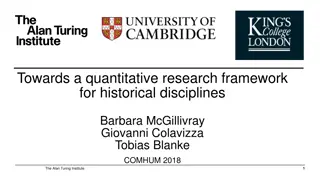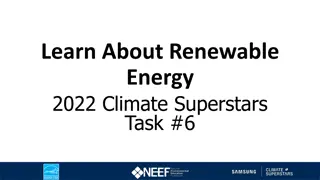Historical Sources as Evidence
Explore the importance of historical sources as evidence in the Victorian Curriculum History context, focusing on how students analyze, evaluate, and utilize sources to create historical explanations and arguments. Discover the significance of primary and secondary sources, perspectives of historica
1 views • 46 slides
Analyzing Historical Sources on Suffragettes, Colonization, and Church Reform
This content focuses on different types of historical sources related to the Suffragette movement, colonization, and Church reform during the medieval period. The primary and secondary sources mentioned include the Tower of London, a letter by William of Normandy, a replica Suffragette sash, Dover C
2 views • 8 slides
Understanding Libyan Civil Law: Sources and Application
Civil law in Libya draws influences from Ottoman, French, Italian, and Egyptian sources, with a move towards a legal system based on Sharia. This article discusses the priority of using Libyan Civil Law sources and emphasizes the importance of laws that cater to the wellbeing of its citizens. The so
1 views • 7 slides
Challenges and Solutions in Implementing Historical Competencies in Teaching
Explore the complexities and obstacles faced in implementing historical competencies in teaching, as discussed by Jens Aage Poulsen, a senior lecturer and researcher at HistoryLab, University College Lillebaelt, Denmark. The content delves into competence-based curriculum, core historical competenci
0 views • 7 slides
Sources of Drugs and Their Origins
Drugs can be sourced from six major categories: plants, animals, minerals/earth, microbiological sources, semi-synthetic sources, synthetic sources, and recombinant DNA technology. Plant sources, being the oldest, provide various medicinal properties through leaves, flowers, fruits, seeds, roots, ba
0 views • 11 slides
Understanding the Debate on Inexhaustible vs. Nonrenewable Energy Sources
The energy debate revolves around the classification of energy sources into nonrenewable, renewable, and inexhaustible categories. Fossil fuels, such as coal, petroleum, and natural gas, fall under nonrenewable sources due to their finite nature, while wind and tidal energy are examples of inexhaust
0 views • 18 slides
Understanding Historical Research Methods
Historical research is a systematic approach to investigating past events, developments, and experiences. It involves critical examination of evidence, interpretation of sources, and tracing of historical trends to gain insights into social changes. Various definitions by scholars like Kerlinger, Wh
1 views • 21 slides
Understanding Information Literacy: A Comprehensive Guide for Students
Information literacy is crucial for academic success. It involves the ability to recognize the need for information, locate relevant sources, evaluate their credibility, and effectively use the information for research and presentations. Primary and secondary sources play a vital role in gathering i
0 views • 19 slides
Understanding Sources of Law in Legal Systems
Exploring the sources of law, this content delves into the concept of formal and material sources categorized by legal scholars. It examines how legal systems differ in recognizing sources such as precedents, legislation, customs, and treaties. The focus shifts to Indian law, highlighting the signif
1 views • 23 slides
Sources for Understanding Modern India's History
Plenty of information on political, social, economic, and cultural developments in Modern India can be found through literary sources like printed books, government documents, newspapers, magazines, pamphlets, historical buildings, biographies, and memoirs. These sources shed light on various aspect
0 views • 9 slides
Understanding the Sources of Law: Definitions and Classification
The term "sources of law" refers to the origins from which rules of human conduct derive their legal force and binding character. This concept varies among writers and includes factors like Hindu scriptures, sovereign authority, historical documents, customs, and more. This article explores differen
0 views • 11 slides
Understanding Light Intensity Variation in Different Sources
Explore the correlation between light intensity and efficiency in various light sources through an intriguing experiment. Delve into the theoretical framework and practical applications to grasp the essence of light intensity and its distribution. Uncover the factors influencing the efficiency of li
0 views • 21 slides
Accelerator Technology R&D Targets and Sources Overview
The SnowMass2021 Accelerator Frontier AF7 focuses on Accelerator Technology R&D, exploring targets and sources such as high brightness electron sources, muon sources, and high intensity ion sources. The community planning meeting discussed various Letter of Interest submissions outlining innovative
0 views • 7 slides
Understanding the Sources for the History of Modern India
The sources for the history of modern India encompass literary sources such as printed books, government documents, newspapers, magazines, pamphlets, historical buildings, biographies, and memoirs. These sources provide insights into the political, social, economical, and cultural developments in In
0 views • 9 slides
Understanding Light: Sources and Properties
Light is a vital form of energy that enables vision and is emitted or reflected by various sources. Learn about natural sources like the sun, moon, fire, lightning, and luminous animals, as well as artificial sources powered by electricity. Discover how light waves travel, illuminating our world and
0 views • 18 slides
Guide to Annotated Bibliography: Sources, Evaluation, and Guidelines
Understand the importance of an annotated bibliography, which includes a list of sources with personal commentary. Learn how to summarize, evaluate, and critique sources for academic research. Follow the guidelines to create entries formatted in MLA style and use appropriate sources for your paper.
0 views • 26 slides
Development of Guidelines for Publishing Georeferenced Statistical Data Using Linked Open Data Technologies
Development of guidelines for publishing statistical data as linked open data, merging statistics and geospatial information, with a primary focus on preparing a background for LOD implementation in official statistics. The project aims to identify data sources, harmonize statistical units, transfor
2 views • 31 slides
Important Milestones in American History and Sources of Information
This content provides a comprehensive overview of different types of historical sources, crucial dates in American history, significant time periods post-Civil War, and key historical documents like the Declaration of Independence. It distinguishes between primary and secondary sources, lists import
0 views • 11 slides
Reliability and Usefulness of Historical Sources
Photographs, diary entries, and letters are valuable historical sources, providing insights into past events. While photographs offer a snapshot of the truth, they can also be manipulated. Diary entries reflect personal experiences authentically but may lack objective facts. Letters serve as private
0 views • 11 slides
Understanding Reliable and Unreliable Sources for Research
Recognize reliable and unreliable sources for research. Reliable sources, such as books and peer-reviewed journals, are authored by experts in the field. Unreliable sources like Wikipedia and blogs can be altered by anyone. Learn how to evaluate the credibility of online sites based on their URLs an
0 views • 10 slides
Requirements for Historical Investigation Internal Assessment
Understand the 25% weightage internal assessment comprising 3 sections for a historical investigation. Focus on source evaluation, investigation, and reflection within a 2,200-word limit. Choose a historical topic, analyze primary and secondary sources, and consider causation, consequence, continuit
0 views • 18 slides
Citing Sources in Research Papers: A Comprehensive Guide
Learn how to correctly cite sources in a research paper through parenthetical citations and creating a Works Cited page. Understand the importance of giving credit to sources to avoid plagiarism. The guide covers the use of quotations to strengthen your arguments, parenthetical citations from specif
0 views • 6 slides
Understanding Primary and Secondary Sources in Research
Primary sources provide firsthand information from the time period being studied, while secondary sources offer interpretations based on primary sources. Examples of primary sources include autobiographies, speeches, historical documents, published firsthand accounts, and sound recordings. Secondary
0 views • 23 slides
International Inventory of Musical Sources by RISM
Founded in Paris in 1952, the Répertoire International des Sources Musicales (RISM) comprehensively documents existing music sources worldwide. Recognized as the key entity for cataloging music sources globally, RISM's working groups in over 35 countries catalog manuscripts, printed music, writings
0 views • 17 slides
Sources for the Study of Ancient Indian History: Literary and Archaeological Insights
Exploring the diverse sources available for studying Ancient Indian History up to 1206 AD, including literary works such as Brahmanical texts, epics like Ramayana and Mahabharata, Buddhist and Jaina literature, and archaeological sources like inscriptions, coins, and material artifacts. These source
0 views • 21 slides
Disused Sources Working Group Report on National Security Perspective
The Disused Sources Working Group (DSWG) report focuses on managing and disposing of sealed sources to reduce national security risks. Formed in 2011, DSWG developed recommendations to enhance the management of disused sealed sources. The report categorizes sealed sources based on potential harm and
0 views • 15 slides
Understanding Indoor Air Pollution: Sources, Impacts, and Control Measures
This study explores the sources and influencing factors of indoor air pollution, highlighting the importance of studying indoor air quality due to its critical impact on human health. It discusses the various pollutant categories from different sources such as outdoor elements, indoor sources, furni
0 views • 17 slides
Understanding Archives and Primary Sources in Research
Explore the meaning of archives, examples of archival sources, the distinction between primary and secondary sources, and how researchers locate archival materials. Delve into the significance of primary sources in research and personal life.
0 views • 14 slides
Understanding Primary and Secondary Sources
Learn about the difference between primary and secondary sources through a quiz based on various historical materials such as Anne Frank's diary, textbooks, interviews, journals, and historical documents like the United States Constitution. Explore the significance of different sources in understand
0 views • 7 slides
Understanding the Importance of Sources in Psychology
Delve into the significance of differentiating between popular and scholarly sources in psychology to enhance research accuracy and reliability. Learn to discern between credible sources and the importance of referencing original sources for accurate information.
0 views • 18 slides
Understanding Energy: Sources, Generation, and Storage
Explore the fundamentals of energy sources, conversion methods, advantages, and disadvantages of non-renewable and renewable sources. Delve into topics such as coal, oil, gas, biomass, solar, wind, and more. Understand the National Grid, power systems, and considerations when selecting energy source
0 views • 6 slides
Understanding Sources of Light and Reflection
Exploring the concept of light sources and reflection, the article delves into how light is created by various objects like the sun, light bulbs, and fires. It explains the difference between sources of light and objects that reflect light, such as shiny metal surfaces. The reader is encouraged to i
0 views • 14 slides
Vulnerability of Radiological Materials to Theft by Terrorist Groups in US Civilian Entities
The vulnerability of radiological materials stored at US civilian entities to theft by terrorist groups, particularly low-activity sources, remains a significant concern. Security measures primarily focus on high-activity sources, leaving lower activity sources neglected and highly susceptible to ex
0 views • 16 slides
Evaluating Sources on Female Rule in the 1550s
This analysis focuses on assessing the reliability and usefulness of historical sources discussing the issue of female rule in the 1550s. It evaluates the content, provenance, and context of the sources to determine their relevance for historians studying the topic. The sources provide insights into
0 views • 8 slides
Activities, Sectors, and Control Technologies in GAINS Research
The GAINS research by Janusz Cofala and Zbigniew Klimont focuses on aggregation criteria for emission sources, macroeconomic parameters such as population and GDP, aggregation of energy-related sources, transport sources, and process sources. It also covers specific VOC processes/sources like solven
0 views • 13 slides
Historical Source Analysis Exam Questions Overview
The provided content outlines exam questions related to historical sources, guiding students on analyzing, evaluating, and interpreting information from different sources. The questions cover a range of topics such as learning from sources, assessing accuracy, understanding significance, and making
0 views • 12 slides
Developing Historical Thinking Skills in AP World History
AP History classes aim to cultivate apprentice historians by fostering historical thinking skills (HTS). These skills include Chronological Reasoning, Comparison and Contextualization, Crafting Historical Arguments, and Historical Interpretation. Each skill set equips students with the ability to an
0 views • 15 slides
Quantitative Research Framework for Historical Disciplines
Scholarly communities in historical disciplines are combining quantitative and qualitative methods to study phenomena that change over time. The proposed general methodological reflection aims to enhance research in historical linguistics through quantitatively driven models and claims. Quantitative
0 views • 18 slides
Raw Materials in Industrial Fermentation Processes
Microorganisms utilized in industrial fermentation require essential raw materials such as water, energy sources, carbon, nitrogen, mineral elements, and sometimes vitamins and oxygen. Various raw materials like cane molasses, beet molasses, cereal grains, starch, glucose, and lactose serve as carbo
0 views • 15 slides
Understanding Renewable Energy and its Benefits in 2022
Renewable energy sources like wind, waves, tides, sunlight, geothermal heat, and biomass play a crucial role in combating climate change by reducing greenhouse gas emissions. This task educates about the differences between renewable and non-renewable energy sources, the benefits of renewables, and
0 views • 10 slides
